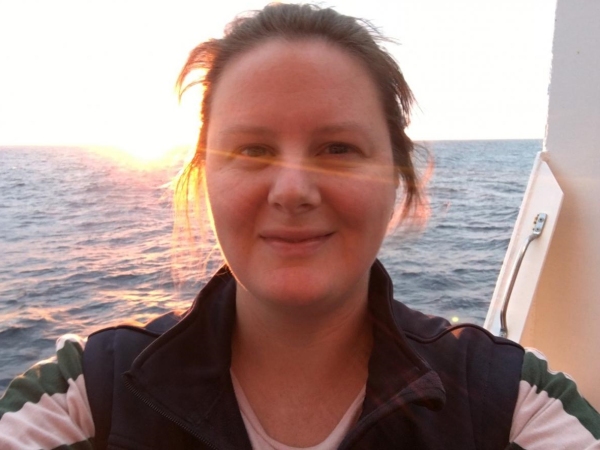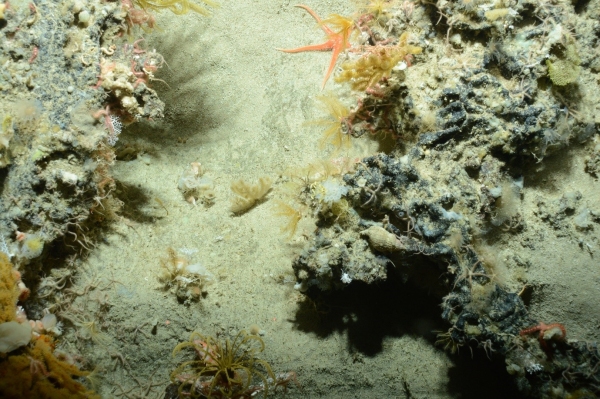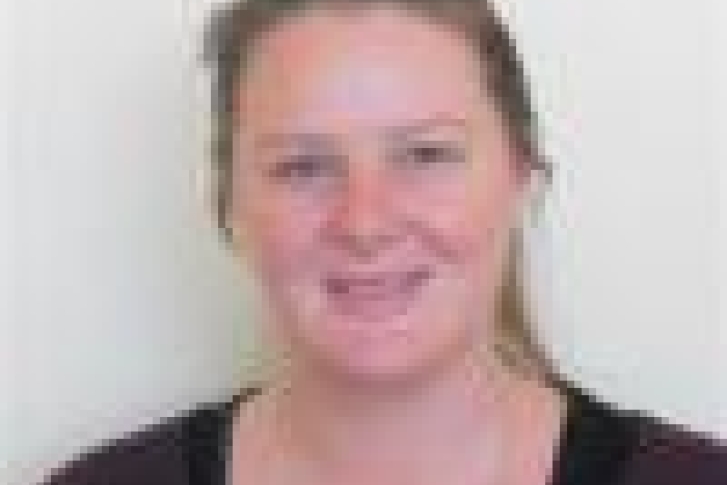Diana Macpherson, benthic data and specimens specialist, talks about what working onboard Tangaroa is really all about.
Where are you from?
Gisborne
How long have you been at NIWA?
6 years
What is your role onboard?
My main job is to identify and record details of the animals, habitats, and substrates observed by the Deep Towed Imaging System (DTIS). Once the DTIS is in the water and being towed very slowly behind the ship, one biologist watches the live feed of the video and calls out what they’re seeing to the other one, including observations about the type of seafloor (muddy or rocky) and the animals that are on it: sea stars, corals, sponges, eels, sharks, jellyfish, etc. The other biologist records the observations into the computer and makes sure the software is recording properly. A DTIS tow goes for 1 hour and afterwards we work together with the electronics technician to download the video and photo data from the cameras, and store them safely. I take one of the biologist jobs, often rotating between them.
When we can’t use the DTIS, we collect physical samples from the seafloor to verify what we are seeing on the video and photos. The beam trawl or sled collects benthic invertebrates, which are sorted onboard into taxon groups (e.g. crabs, sea pens, isopods, etc.). They are weighed, entered into our NIWA Invertebrate Collection database, labelled, photographed and curated. I help slice up core samples and identify, record and curate benthic invertebrate specimens.
Describe a typical day while at sea
I’m on the midnight to midday shift, so I wake up at 23:00, take a shower then go upstairs to the mess room for something to eat and drink while I wake up. At 23:50 I head downstairs to the Hydro Dry lab (DTIS lab) to see the other shift for a quick changeover chat. They head off to bed while we take over whatever they were doing. Sometimes it’s right in the middle of a DTIS tow.
Depending on the transit times between sites and the water depth, we do about three or four DTIS tows in per shift. The depth can be between 100 m and 2000 m, and it can take the DTIS 20-30 mins to reach the seafloor for some deep sites. Between tows we fit in a morning tea break at 03:00 and the cooks cook us a proper breakfast at 06:30 (which is really our lunch). A second morning tea break is at 10:00 and a midday feast is ready for us at 12:00. We then have 12 hours to relax, watch a movie, catch up on emails if the internet is working well, and sleep before the next shift.
What is the best part about your job?
My favourite part of my job at sea is the thrill of discovery and seeing something that no one has seen before. Much of New Zealand’s seafloor is still uncharted territory, so you never know what you’re going to see on the DTIS cameras! Individual specimens are pretty amazing, particularly corals like bamboo corals, sea fans and black corals, and echinoderms like crinoids and ophiuroids, but I really enjoy seeing a whole community of different organisms together in their habitat. Just one cobble on a vast muddy seafloor can provide enough hard substrate for sessile organisms to attach to, like anemones, sponges and corals which in turn attract organisms that can move like squat lobsters, sea stars, sea snails and fish that use the others for food and shelter.
What did you study and what kind of work did you do before that lead to doing this job?
I completed a BSc(Tech) in Marine Science and a MSc in Earth and Ocean Science from the University of Waikato. The BSc(tech) was a four-year degree including one year of work experience which I completed at NIWA Hamilton and NIWA Wellington. After completing my MSc I worked a variety of casual contracts while I applied for jobs, from reception work and waitressing to working in a chemistry lab processing paua samples for heavy metal testing (in response to the Rena disaster), and measuring whitebait for a PhD candidate's research, to volunteering at the University of Waikato Coastal Marine Field Station in Tauranga. I even volunteered as a helper for a RV Tangaroa voyage before I started working at NIWA.



